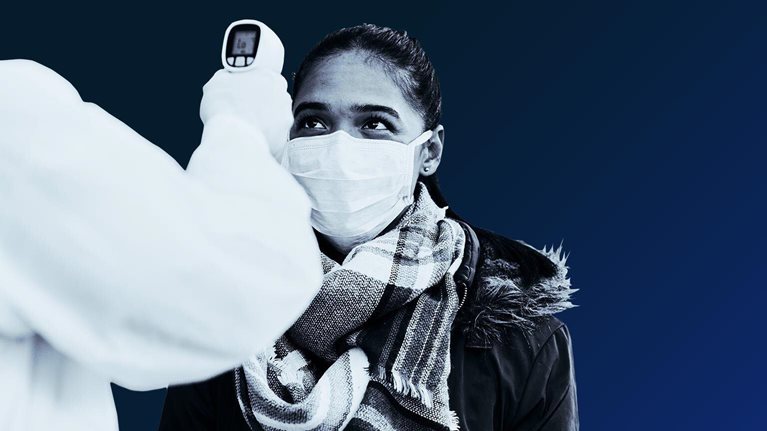“The fault lines between industries and business models that we understood intellectually before the COVID-19 crisis have now become giant fissures, separating the old reality from the new one.” Our colleagues in the Strategy practice wrote this in their article, “The Great Acceleration.” We see seeds being sown of a similar acceleration in healthcare during the COVID-19 era. As US healthcare leaders set the direction for their organizations, six trends stand out.

Reform
COVID-19 has potentially set the stage for healthcare reform along three dimensions: COVID-19-era waivers that could become permanent; actions that may be taken to strengthen the healthcare system to deal with pandemics; and reforms to address the COVID-19-induced crisis.
To enable the healthcare system to respond to the pandemic, the Centers for Medicare & Medicaid Services has introduced more than 190 waivers and modifications since the beginning of March 2020.1 These actions impact the clinical practice of medicine and the financing and reimbursement for services. Many of these measures are only relevant during the crisis (for example, the waiver of intensive care unit death reporting). A retrospective assessment of others (for example, expansion of telehealth access) could reveal beneficial innovation worth preserving.
The frontline workers and leaders in healthcare took heroic action to save lives. At the same time the crisis has revealed areas that could improve the resilience of the system. Some of these opportunities include ramping up measures to control the spread of such a fast-moving virus, greater resilience in the healthcare system to avoid being overwhelmed (for example, addressing weak links within the medical supply chain and developing the ability to flex up critical care capacity and clinical workforce), as well as ways to improve the baseline health of the population (for example, offering services to mitigate the prevalence of chronic conditions and obesity rates).
The economic impact of COVID-19 is unprecedented in the last 75 years, creating historic economic pressure across federal and state governments, corporations, and American households (Exhibit 1). Furthermore, in some cases the impact of COVID-19 may cause up to roughly 10 million Americans to lose employer-sponsored healthcare coverage by the end of 2021.2 In the United States, such economic dislocation has often been followed by major healthcare reform (Exhibit 2). If the United States embarks on new reform, the contours are unclear at this time. However, given the substantial shifts in relative market positioning among industry players that prior reforms have created, leaders would do well to plan ahead now, as we discussed in the article “Getting ahead of the next stage of the coronavirus crisis.”


Would you like to learn more about our Healthcare Systems & Services Practice?
Health for all
COVID-19 has amplified existing inequitable health outcomes. These five intersecting health and social conditions are correlated with poorer health outcomes.
- Physical health status. People with chronic conditions, the immunocompromised, and the elderly make up most COVID-19 deaths in the United States. For example, obese patients, defined as those with a Body Mass Index above 35, are 2 times more likely to be hospitalized and 3.5 times as likely to be admitted to the intensive care unit due to COVID-19.3
- Behavioral health challenges. Individuals at an increased risk of developing severe COVID-19 symptoms are nearly twice as likely to have a behavioral health condition, including mental health and substance abuse disorders.4
- Unmet social needs. Americans living in areas with significant unmet social needs (for example, food insecurity, housing insecurity) account for 15 percent of the population but 28 percent of COVID-19 deaths.5 In areas with high unemployment levels, COVID-19 deaths per 100,000 are 2.4 times higher than in areas with low unemployment.
- Racial inequity. Compared with white Americans, the estimated age-adjusted COVID-19 mortality rate for Black Americans is 3.8 times, for American Indians 3.2 times, and for Hispanic/Latinx Americans 2.5 times.6
- Access to care. Challenges in access to care continue across the United States, with around 60 million Americans living in counties with low physical access to care.7 Furthermore, around 63 percent of all counties in the United States have a shortage of psychiatrists.8 Telehealth offers a great opportunity to expand access: inadequate physical access to care could be redressed for up to an additional 50 million Americans. However, 10 million Americans still do not have broadband access and live in areas with low physical access to care (Exhibit 3).9

Era of exponential improvement unleashed
As we previously highlighted in “The era of exponential improvement in healthcare?,” technology-driven innovation may improve our understanding of patients, enable the delivery of more convenient, individualized care, and create from $350 billion to $410 billion in annual value by 2025. While the pace of change in healthcare has lagged other industries in the past, potential for rapid improvement may accelerate due to COVID-19. An example is the exponential uptake of digitally enabled, virtual care. Our analysis presented in “Telehealth: A quarter-trillion-dollar post-COVID-19 reality?” showed that health systems, primary care, and behavioral health practices are reporting increases of more than 50–175 times in telehealth visits, and the potential market size for virtual care could reach around $250 billion (Exhibit 4).

Proliferation of digitally enabled, virtual care could further contribute to the rise of personalized and intuitive healthcare ecosystems. As we shared in “The next wave of healthcare innovation: The evolution of ecosystems,” ecosystems in healthcare have the potential to deliver an integrated experience to consumers, enhance productivity of providers, engage both formal and informal caregivers, and improve outcomes while lowering cost.
The big squeeze
While the aftermath of the 2008–09 financial crisis led to a net outflow due to the transition of commercially insured employees to uninsured, the Affordable Care Act brought an injection of $130 billion-plus of funding into healthcare (for example, Medicaid expansion, funding for the marketplace). However, a similar injection of funding to mitigate the $70 billion and $100 billion outflow (for example, coverage shifts, state budgetary pressures) due to COVID-19 may not take place by 2022. This outflow is expected to be primarily driven by coverage shifts out of employer-sponsored insurance and possible coverage reductions by employers as well as Medicaid rate pressures from states.
We estimate that COVID-19 could depress healthcare industry earnings by between $35 billion and $75 billion compared with baseline expectations. Select high-growth segments will remain attractive (for example, virtual care, home health, software and platforms, specialty pharmacy) and will disproportionally drive growth. These high-growth areas are expected to increase more than 10 percent over the next five years, while other segments may stagnate or decline altogether.10
Despite the pressure in earnings, organizations with businesses that operate in the lower-growth segments may still outperform and deliver higher-growth returns by improving productivity. We estimate between $280 billion and $550 billion in opportunity within healthcare delivery by 2028 achievable through productivity gains. More details can be found in our publication “The productivity imperative for healthcare delivery in the United States.”
Fragmented, integrated, consolidated care delivery
The shift of care out of hospitals is not new but has been accelerated by COVID-19. Care in the next normal could be increasingly delivered in distributed sites of care (Exhibit 5), integrated around the patient through digital and analytics across patient-centered ecosystems, and driven by at-scale players pursuing proven models to outperform. Larger, geographically diversified providers are weathering the financial impacts of COVID-19 better.11 These systems also own an outsized share of the distributed, outpatient assets that could drive earnings growth in the next normal. For example, the largest 25 percent of health systems generate 60 percent of revenue from outpatient assets compared with around 40 percent for smaller systems.12 Furthermore, large payers have rapidly become major owners of non-hospital care delivery assets, with nine out of ten top payers already owning distributed, outpatient assets.13

Next generation managed care accelerated
Payers pursuing the next generation managed care model (through deep integration with care delivery) demonstrate better financial performance, capturing an additional 50 basis points of earnings before interest, taxes, depreciation, and amortization above expectation (Exhibit 6). This next generation managed care model has been driven in large part through Medicare Advantage, where positive outcomes have been delivered to beneficiaries.

As discussed earlier, the current crisis is placing substantial pressure on employers’ economics. However, the primary lever of shifting costs to employees to promote value conscious consumption has run out of steam. In 2019, average employee contribution for family coverage was 32 percent at employers with more than 500 employees and 53 percent for smaller employers with less than 500 employees. The intense pressure on household financials makes the overall healthcare exposure larger than many consumers’ ability to absorb (Exhibit 7). Employers and payers could consider fundamentally rethinking how employer-sponsored health coverage is structured. Learnings from Medicare Advantage (Exhibit 8) could provide inspiration for such a reimagination.



COVID-19: Saving thousands of lives and trillions in livelihoods
What actions could you take?
- Launch a plan-ahead team to collect forward-looking intelligence, develop scenarios, and identify decision points for action to navigate uncertainty in the path to the next normal. As we outlined in “Getting ahead of the next stage of the coronavirus crisis,” planning ahead for crises requires a dedicated effort, with a full-time senior executive leading and accountable for a team of high performers located “next door” to the CEO.
- Question everything about your role in healthcare and future business model as your organization transitions from “wartime” to “peacetime.” More details on the transition can be found in our article “From “wartime” to “peacetime”: Five stages for healthcare institutions in the battle against COVID-19.”
- Ramp up capabilities to transform your business, including acquisitions and alliances. Our two decades of research outlined in the article “The power of through-cycle M&A” show that a through-cycle mind-set to M&A can enable and accelerate the strategic shifts necessary to emerge from the COVID-19 crisis healthy and profitable.
- Reimagine your organization to lock in the speed of decision making and execution achieved during the crisis. In “Ready, set, go: Reinventing the organization for speed in the post-COVID-19 era,” we share nine discrete ways companies can get faster.
- Lean forward on actions to drive health equity. We expressed the criticality of tracking the damage of COVID-19 and the recovery from the pandemic along racial lines in “COVID-19: Investing in black lives and livelihoods.” It is incumbent on all stakeholders to take proactive action to mitigate disparities and push toward health for all.
While the challenges are numerous, leaders who seize the mindset that “disruptive change provides an opportunity to separate yourself from the pack” will build organizations meaningfully stronger than the ones they ran going into the crisis.


